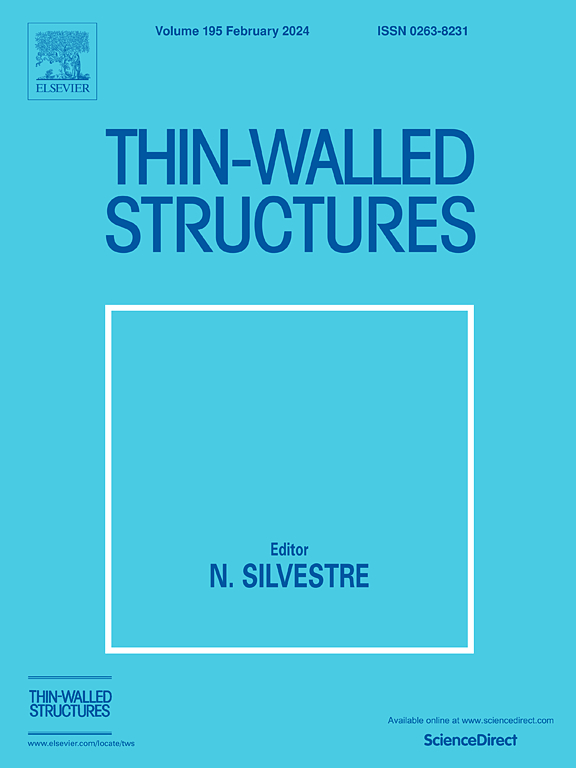不同芯材拓扑结构的 CFRP 蜂窝的面内挤压行为和能量吸收
IF 5.7
1区 工程技术
Q1 ENGINEERING, CIVIL
引用次数: 0
摘要
在单轴加载条件下,实验研究了不同芯材拓扑结构的碳纤维增强聚合物(CFRP)蜂窝的面内挤压行为和能量吸收性能。设计中考虑了三种类型的 CFRP 蜂窝芯拓扑结构(即圆形、方形和六角形)以及不同的蜂窝壁厚度和高度。蜂窝样品是通过模塑和粘接工艺制造的,这种工艺被广泛应用于薄壁蜂窝结构的简易、快速和经济制造。在每种加载条件下,共对二十七组样品进行了实验测试,其中不同芯拓扑结构的蜂窝样品被设计成具有几乎相同的重量,以便进行有意义的比较。实验结果表明,所有蜂窝设计在膨胀方向上都具有较高的平面抗压强度,而六边形蜂窝由于其稳定的承载能力和出色的受力效率,在两个方向上都表现出了最高的强度和能量吸收性能。实验结果尤其表明,通过适当调整蜂窝壁厚和高度参数,CFRP 蜂窝结构的抗压强度和比能量吸收能力可分别提高 6.1 倍和 4.2 倍。实验结果还显示,所提出的结构密度为 155-283 公斤/立方米的轻质 CFRP 蜂窝结构与许多竞争蜂窝拓扑结构相比,具有更好的面内挤压性能。本文章由计算机程序翻译,如有差异,请以英文原文为准。
In-plane crushing behavior and energy absorption of CFRP honeycombs with different core topologies
The in-plane crushing behavior and energy absorption performance of carbon fiber reinforced polymer (CFRP) honeycombs with different core topologies were experimentally investigated under uniaxial loading conditions. Three types of CFRP honeycomb core topologies (i.e. circular, square and hexagonal) with different cell wall thicknesses and heights were considered in the designs. The honeycomb samples were fabricated by the molding and bonding process, which is widely used in the easy, fast and economical manufacturing of thin-walled honeycomb structures. A total of twenty-seven sample groups were experimentally tested for each loading condition, in which honeycomb samples with different core topologies were designed to have almost the same weights for a meaningful comparison. The experimental results revealed that all honeycomb designs have higher in-plane compression strength in the expansion direction, and hexagonal honeycombs showed the highest strength and energy absorption performance in both directions due to their stable load-carrying capacity and outstanding force efficiency. In particular, the experimental findings showed that the crushing strength and the specific energy absorption of CFRP honeycomb structures can be improved up to 6.1 and 4.2 times, respectively, by properly adjusting the cell wall thickness and height parameters. The results also revealed that the proposed lightweight CFRP honeycombs with the structural densities of 155–283 kg/m3 showed better in-plane crushing performance than many competing cellular topologies.
求助全文
通过发布文献求助,成功后即可免费获取论文全文。
去求助
来源期刊

Thin-Walled Structures
工程技术-工程:土木
CiteScore
9.60
自引率
20.30%
发文量
801
审稿时长
66 days
期刊介绍:
Thin-walled structures comprises an important and growing proportion of engineering construction with areas of application becoming increasingly diverse, ranging from aircraft, bridges, ships and oil rigs to storage vessels, industrial buildings and warehouses.
Many factors, including cost and weight economy, new materials and processes and the growth of powerful methods of analysis have contributed to this growth, and led to the need for a journal which concentrates specifically on structures in which problems arise due to the thinness of the walls. This field includes cold– formed sections, plate and shell structures, reinforced plastics structures and aluminium structures, and is of importance in many branches of engineering.
The primary criterion for consideration of papers in Thin–Walled Structures is that they must be concerned with thin–walled structures or the basic problems inherent in thin–walled structures. Provided this criterion is satisfied no restriction is placed on the type of construction, material or field of application. Papers on theory, experiment, design, etc., are published and it is expected that many papers will contain aspects of all three.
 求助内容:
求助内容: 应助结果提醒方式:
应助结果提醒方式:


